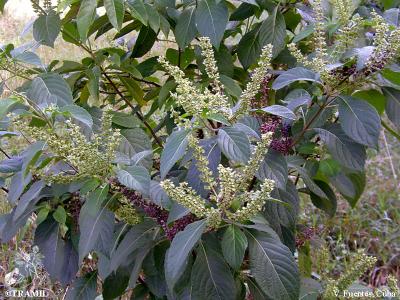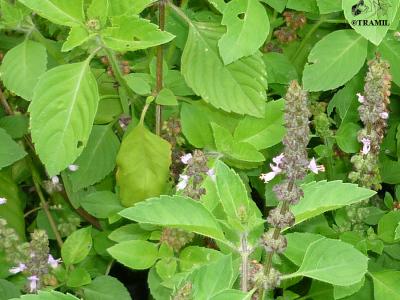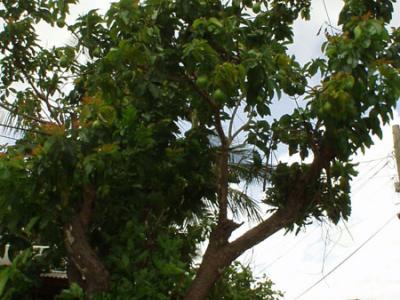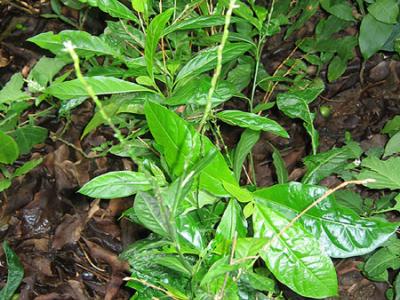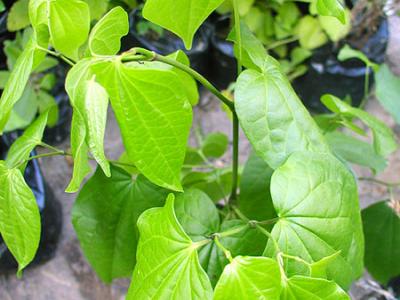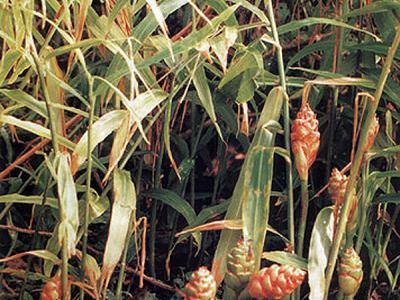(dans les territoires avec usage significatif TRAMIL)
République dominicaine:
- albahaca vaca
Haïti:
- atiyayo
- gwo fonbazen
Guatemala:
- basen
Sainte-Lucie:
- vanne van
feuille, décoction ou infusion, voie orale2-3
Selon l’information disponible :
L’emploi contre les douleurs abdominales et les flatulences est classé REC sur la base de l’emploi significatif traditionnel documenté par les enquêtes TRAMIL, les études de validation, de toxicité et l’information scientifique publiée.
Si l’état du patient se détériore ou si les douleurs abdominales durent plus de 3 jours, consulter un médecin.
L’emploi contre le myasis est classé REC sur la base de l’expérience traditionnelle de l’usage documenté par son emploi significatif traditionnel documenté par les enquêtes TRAMIL et l’information scientifique publiée.
Toute application topique doit se conformer à de strictes mesures d’hygiène pour éviter la contamination ou une infection supplémentaire.
Ne pas employer avec des femmes enceintes ou allaitantes, ni avec des enfants de moins de 5 ans.
Les feuilles d’Ocimum gratissimum constituent un condiment de consommation humaine relativement répandu.
Contre les douleurs abdominales ou les flatulences :
Préparer une décoction ou une infusion avec 7 grammes de feuilles dans 1 tasse (1/4 litre) d’eau. Pour la décoction, faire bouillir 5 minutes dans un récipient couvert (avec éventuellement une pincée de sel).
Pour l’infusion, verser l’eau bouillante sur les feuilles, couvrir et laisser reposer 5 minutes. Laisser refroidir, filtrer et boire 1 tasse 3 fois par jour.
Contre le myasis :
Laver correctement la feuille et l’écraser, en quantité suffisante pour la placer à l'intérieur du nez, préalablement lavé avec de l'eau bouillie, en forme de bouchon, à appliquer 4 fois jour4.
Toute préparation médicinale doit être conservée au froid et utilisée dans les 24 heures.
1 WENIGER B, 1987-88
Encuesta TRAMIL. enda-caribe, Santo Domingo, Rep. Dominicana.
2 WENIGER B, ROUZIER M, 1986
Enquête TRAMIL. Service Oecuménique d'Entraide SOE, Port au Prince, Haïti.
3 JEAN-PIERRE L, 1988
TRAMIL survey. St. Lucia national herbarium, Castries, St Lucia.
4 GIRÓN L, 1988
Encuesta TRAMIL (Costa atlántica). Centro Mesoamericano de Tecnología CEMAT, Guatemala, Guatemala.
5 WENIGER B, SAVARY H, DAGUIHL R, 1984
Tri phytochimique de plantes de la liste TRAMIL. Laboratoire de chimie des substances naturelles, Faculté de Médecine et de Pharmacie, Université d'Etat d'Haïti, Port au Prince, Haïti.
6 ZAMUREENKO VA, TOKAREVA VY, KLYUEV NA, KARPOVA TI, GRANDBERG TI, 1981
Identification of sesquiterpene hydrocarbons of essential oil from Ocimum gratissimum L. Izv Timiryazevsk S-Kh Akad 1981(4):153-155.
7 NTEZURUBANZA L, SCHEFFER JJC, BAERHEIM-SVENDSEN A, 1987
Composition of the essential oil of Ocimum gratissimum grown in Rwanda. Planta Med 53(5):421-423.
8 ARCTANDER S, 1960
Perfume and flavor materials of natural origin. Elizabeth, USA: Stephen Arctander.
9 HEGNAUER R, 1973
Chemotaxonomy der Pflanzen. Basel, Schweiz: Birkhauser Verlag. 6:882.
10 MAIA JGS, RAMOS LS, LUZ AIR, DA SILVA ML, ZOGHBI MG, 1988
Uncommon Brazilian essential oils of the Labiatae and Compositae. In: Flavors and fragrance: a world perspective, Proceedings of the 10th International Congress of Essential Oils. Lawrence BM, Mookherjee BD, Willis BJ, Eds. New York, USA: Elsevier Sci Publ. pp:177-188.
11 JANSSEN AM, SCHEFFER JJC, NTEZURUBANZA L, SVENDSEN AB, 1989
Antimicrobial activities of some Ocimum species grown in Rwanda. J Ethnopharmacol 26(1):57-63.
12 NIGAM M, KHOSLA MK, BRADU BL, TANDON N, 1988
Hydration of terpene fraction of "clocimum" oil and isolation of pure myrcene. Parfume Kosmet 69(5):285-286.
13 OFFIAH VN, CHIKWENDU UA, 1999
Antidiarrhoeal effects of Ocimum gratissimum leaf extract in experimental animals. J. Ethnopharmacol 68(1-3):327-330.
14 AZIBA PI, BASS D, ELEGBE Y, 1999
Pharmacological investigation of Ocimum gratissimum in rodents. Phytother Res 13(5):427-429.
15 NJOKU CJ, ASUZU IU, 1998
The anthelmintic effects of the leaf extract of Ocimum gratissimum (L.). Phytomedicine 5(6):485-488.
16 MADEIRA SV, MATOS FJ, LEAL-CARDOSO JH, CRIDDLE DN, 2002
Relaxant effects of the essential oil of Ocimum gratissimum on isolated ileum of the guinea pig. J Ethnopharmacol 81(1):1-4.
17 ORAFIDIYA LO, AGBANI EO, OYEDELE AO, BABALOLA OO, ONAYEMI O, 2002
Preliminary clinical tests on topical preparations of Ocimum gratissimum Linn. leaf essential oil for the treatment of acne vulgaris. Clinical Drug Investigation 22(5):313-319.
18 ORAFIDIYA LO, AGBANI EO, ABEREOJE OA, AWE T, ABUDU A, FAKOYA FA, 2003
An investigation into the wound-healing properties of essential oil of Ocimum gratissimum Linn. J Wound Care 12(9):331-334.
19 PEREIRA SL, DE OLIVEIRA JW, ANGELO KK, DA COSTA AM, COSTA F, 2011
Clinical effect of a mouth rinse containing Ocimum gratissimum on plaque and gingivitis control. J Contemp Dent Pract 12(5):350-355.
20 BUDAVARI S (Ed.), 2001
The Merck index: an encyclopedia of chemical, drugs, and biologicals. 30th ed. White House Station, New Jersey, USA: Merck & Co., Inc. p1676.
21 ONAJOBI FD, 1986
Smooth muscle contracting lipid-soluble principles in chromatographic actions of Ocimum gratissimum. J Ethnopharmacol 18(1):3-11.
22 GUERRA MJ, LÓPEZ M, BOUCOURT E, FUENTES V, MORÓN F, 2002
Toxicidad aguda (DL50) de decocción de hojas frescas de Ocimum gratissimum L. Informe TRAMIL. Laboratorio Central de Farmacología. Facultad de Medicina “Dr. Salvador Allende”. La Habana, Cuba.
23 GUERRA MJ, LÓPEZ M, BOUCOURT E, FUENTES V, MORÓN F, 2002
Clases toxicas agudas de decocción (30%) de hojas frescas de Ocimum gratissimum L. Informe TRAMIL. Laboratorio Central de Farmacología. Facultad de Medicina “Dr. Salvador Allende”. La Habana, Cuba.
24 GUERRA MJ, LÓPEZ M, BOUCOURT E, FUENTES V, 2002
Toxicidad aguda (DL50) de extracto fluido 30% de hojas secas de Ocimum gratissimum L. Informe TRAMIL. Laboratorio Central de Farmacología. Facultad de Medicina “Dr. Salvador Allende”. La Habana, Cuba.
25 GUERRA MJ, LÓPEZ M, BOUCOURT E, FUENTES V, 2002
Genotoxicidad in vivo: ensayo de micronúcleos en médula ósea de extracto fluido 30% de hojas secas de Ocimum gratisimum L. Informe TRAMIL. Laboratorio Central de Farmacología. Facultad de Medicina “Dr. Salvador Allende”, La Habana, Cuba.
26 LOGARTO A, SILVA R, GUERRA I, IGLESIAS L, 2001
Comparative study of the assay of Artemia salina L. and the estimate of the medium lethal dose (LD50 value) in mice, to determine oral acute toxicity of plant extracts. Phytomedicine 8(5):395-400.
27 LOGARTO A, TILLAN J, VEGA R, GONZÁLEZ YC, 1999
Toxicidad aguda oral de extractos hidroalcohólicos de plantas medicinales. Rev Cubana Planta Med 4(1):26-28.
28 DHAWAN BN, PATNAIK GK, RASTOGI RP, SINGH KK, TANDON JS, 1977
Screening of Indian plants for biological activity. VI. Indian J Exp Biol 15(3):208-219.
29 PILOTO J, VIZOSO A, RAMOS A, GARCÍA A, REMIGIO A, VEGA Y, GONZÁLEZ ML, RODRÍGUEZ C, CARBALLO C, 2009
Plantas medicinales. Diez años de evaluaciones toxicogenéticas en el CIDEM. Boletín Latinoamericano y del Caribe de Plantas Medicinales y Aromáticas, 8(5):428-434.


